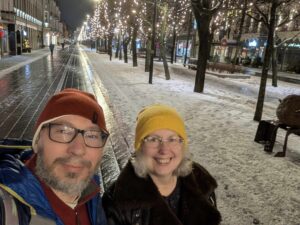 Welcome to Kaunas
Welcome to Kaunas
Welcome to Kaunas, as Writing with Labradors tackles a whole new challenge. Leaving the Peninsular War and Royal Navy behind for a short time, I’ve arrived in Lithuania as a medical tourist to get my right hip replaced.
 I’ve written before about the difficulties I’ve had getting treatment for severe osteoarthritis in my hips. After a lot of heart searching and even more research, my husband and I decided to take the plunge and go overseas for the operation. We read a lot about Lithuania, particularly the Nord Clinic in Kaunas, joined a patient group on Facebook and before Christmas we booked to make the trip, leaving Oscar and Alfie in the care of Jon, Anya and Anya’s partner Ollie.
I’ve written before about the difficulties I’ve had getting treatment for severe osteoarthritis in my hips. After a lot of heart searching and even more research, my husband and I decided to take the plunge and go overseas for the operation. We read a lot about Lithuania, particularly the Nord Clinic in Kaunas, joined a patient group on Facebook and before Christmas we booked to make the trip, leaving Oscar and Alfie in the care of Jon, Anya and Anya’s partner Ollie.
Largely because of how much worse my mobility has got over the past year, we’ve not travelled much. I had a relaxed break in Mallorca at the end of 2023 and a few short trips to visit family or to attend conferences during 2024. This trip to Kaunas hardly counts as a holiday but there was still a sense of anticipation as Christmas came and went and it was time to pack for the journey.
In the chaos of packing, organising the house and trying to get the broken central heating fixed before setting off, it didn’t occur to me I was going to be nervous, but the day before we were due to travel I unexpectedly realised I was absolutely terrified. It suddenly seemed insane that I was about to set off to a country I’d never visited to have a major operation. No matter how much I’d read about the excellent record and glowing testimonials for the Nord Clinic I wanted to cancel the whole thing and go back to bed. My poor husband patiently talked me down from my panic, soothed my tearful moments and reminded me how much better my life would get when I could walk my dogs on the beach or in the forest again.
Travelling off island in winter is always a slightly risky proposition and we watched the weather reports with growing concern as snow and ice were predicted. This is seldom too much of a problem on the island but it’s a different matter in the UK and on Sunday morning we woke to news that whole areas of the UK had been affected and that Liverpool airport was temporarily closed while they tried to clear the runways and de-ice the plane. We went to Ronaldsway and waited, stress rising as the flight was delayed, then delayed again. We were due to stay overnight in Liverpool but if we didn’t make it that day we would miss our connecting flight on Monday to Kaunas and the whole thing would have to be rearranged.
 A day of stress, virtually no food and complete exhaustion ended with us collapsing into bed in the Liverpool Airport Premier Inn. We got to the airport so late that it was closed and the passenger assistance we had booked completely failed, leaving us stranded on the plane. I’d like to give a heartfelt shout out to the EasyJet pilot, Mark. It wasn’t his job to wait behind with us, to chase up a man with a wheelchair or to personally help Richard to get me down the icy steps from the plane. He then went off to track down our checked-in luggage and escorted us to the taxi rank to make sure I was okay. That man went well beyond the call of duty and I’ll never forget how kind he was.
A day of stress, virtually no food and complete exhaustion ended with us collapsing into bed in the Liverpool Airport Premier Inn. We got to the airport so late that it was closed and the passenger assistance we had booked completely failed, leaving us stranded on the plane. I’d like to give a heartfelt shout out to the EasyJet pilot, Mark. It wasn’t his job to wait behind with us, to chase up a man with a wheelchair or to personally help Richard to get me down the icy steps from the plane. He then went off to track down our checked-in luggage and escorted us to the taxi rank to make sure I was okay. That man went well beyond the call of duty and I’ll never forget how kind he was.
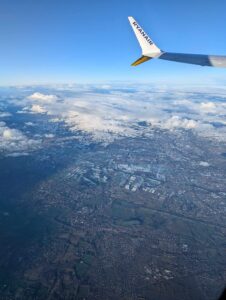 Things went much better the following day and we arrived in a snowy Kaunas to be met by the Nord Clinic driver who took us to the Hotel Kaunas. Fear of not making it in time was now replaced by fear of something going wrong with the pre-operation check-up which would prevent me having the surgery. I have no idea why I thought this might be an issue. Apart from the arthritis I’m in excellent health, very seldom get so much as a cold and had no reason to think that had suddenly changed. It turns out that pre-battle nerves can take some strange forms.
Things went much better the following day and we arrived in a snowy Kaunas to be met by the Nord Clinic driver who took us to the Hotel Kaunas. Fear of not making it in time was now replaced by fear of something going wrong with the pre-operation check-up which would prevent me having the surgery. I have no idea why I thought this might be an issue. Apart from the arthritis I’m in excellent health, very seldom get so much as a cold and had no reason to think that had suddenly changed. It turns out that pre-battle nerves can take some strange forms.
Fortunately my fears turned out to be as unnecessary as my patient husband had said they would be. All was well at the clinic this morning and with the knowledge that the surgery can go ahead, along with my first experience of the kindness and professionalism of the Nord Clinic staff, my mood improved significantly. Suddenly I realised I was in a new city, the snow had mostly gone, though it was cold and drizzling rain and I wanted to go out.
Richard made faint murmuring sounds about whether it was wise to go for a walk when the pavements are still covered in slush and I forgot to bring my walking stick from home. He didn’t really argue for long though. I’d spent far too long inside over the past few days, perched on uncomfortable airport seats or wedged painfully into airplane seats without enough leg room. I set off with a mission; I wanted to see the river and at least a little bit of the old town. Richard had a mission of his own which was to buy me a new walking stick before I killed myself.
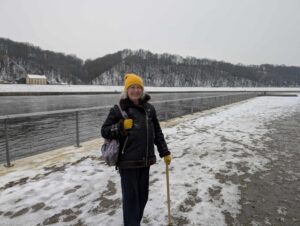 Both missions were successful. We made it down to the old town despite slightly miserable weather and once we got there, Richard gleefully spotted some rather lovely hand carved walking sticks in a shop which sold local arts and crafts. The shopkeeper helped me to test for the right size and I was delighted with my new stick, for several reasons. It will enable me to make the most of my limited visit to Kaunas before I’m laid up after the operation. It will also be a rather lovely souvenir. Finally, it made me think affectionately of my late father, who bequeathed me a fine collection of walking sticks, mainly because of the number of times he left home without his and had to buy a new one while he was away. I felt like a bit of an idiot for forgetting mine but I’m rather pleased now. I just have to make sure I don’t leave this one in the hotel room.
Both missions were successful. We made it down to the old town despite slightly miserable weather and once we got there, Richard gleefully spotted some rather lovely hand carved walking sticks in a shop which sold local arts and crafts. The shopkeeper helped me to test for the right size and I was delighted with my new stick, for several reasons. It will enable me to make the most of my limited visit to Kaunas before I’m laid up after the operation. It will also be a rather lovely souvenir. Finally, it made me think affectionately of my late father, who bequeathed me a fine collection of walking sticks, mainly because of the number of times he left home without his and had to buy a new one while he was away. I felt like a bit of an idiot for forgetting mine but I’m rather pleased now. I just have to make sure I don’t leave this one in the hotel room.
Our hotel is on the Laisvės Alėja which translates as Liberty Boulevard. It is apparently the longest pedestrian street in Eastern Europe and was mostly built in the late nineteenth and early twentieth century. On our way down to the old town we passed an open square with several statues and a memorial plaque. It looks a little bare at this time of year though I suspect it must be pretty in the summer months. The plaque tells a tragic story from a very different era to the one I’m used to reading and writing about. It is a memorial to Romas Kalanta, a 19-year-old Lithuanian student who killed himself by self-immolation in an act of protest against the Soviet regime in Lithuania.
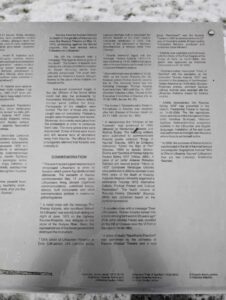 At noon on 14 May 1972, Kalanta poured three litres of petrol over himself and set himself on fire in the square in front of the Kaunas State Musical Theatre where, in 1940, a puppet legislature had declared the establishment of the Lithuanian Soviet Socialist Republic and petitioned the Soviet Union to admit Lithuania as one of the soviet socialist republics. He left a note on a bench which blamed the regime for his death. Kalanta’s suicide. His death provoked a wave of anti-Soviet public demonstrations throughout 1972 and 1973 including 13 other suicides by fire.
At noon on 14 May 1972, Kalanta poured three litres of petrol over himself and set himself on fire in the square in front of the Kaunas State Musical Theatre where, in 1940, a puppet legislature had declared the establishment of the Lithuanian Soviet Socialist Republic and petitioned the Soviet Union to admit Lithuania as one of the soviet socialist republics. He left a note on a bench which blamed the regime for his death. Kalanta’s suicide. His death provoked a wave of anti-Soviet public demonstrations throughout 1972 and 1973 including 13 other suicides by fire.
I’d done a little reading about the history of Lithuania before setting out on this trip, so I knew the outline of its struggle with the Soviet Union. Reading about a nineteen year old giving his life in such a horrific way brought the background sharply into focus. As always, it’s the story of individuals that makes history real for me and this was such a sad one.
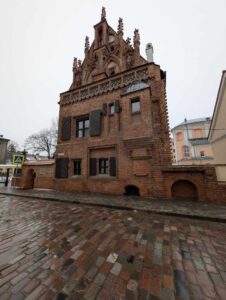 There are some lovely buildings in the old town, though slippery streets and some major building work meant I was cautious about exploring as much as I wanted to. I really took a liking to this particular house though. It’s known as the House of Perkunas which means the House of Thunder and was named after a sculpture of the god Perkunas which was found in the house during some renovations in 1818. The house was built at the end of the fifteenth century by a wealthy townsman and was later the home of a famous Jesuit historian. In 1844 the first drama theatre in Kaunas was established there. In 1991 it was returned to the Jesuits and is now used for educational purposes as well as housing a museum dedicated to the poet Adam Mickiewicz.
There are some lovely buildings in the old town, though slippery streets and some major building work meant I was cautious about exploring as much as I wanted to. I really took a liking to this particular house though. It’s known as the House of Perkunas which means the House of Thunder and was named after a sculpture of the god Perkunas which was found in the house during some renovations in 1818. The house was built at the end of the fifteenth century by a wealthy townsman and was later the home of a famous Jesuit historian. In 1844 the first drama theatre in Kaunas was established there. In 1991 it was returned to the Jesuits and is now used for educational purposes as well as housing a museum dedicated to the poet Adam Mickiewicz.
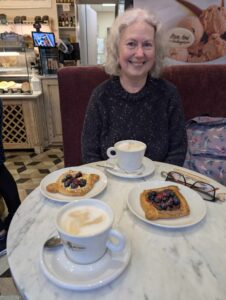 By the time I staggered back to the hotel I was in some pain, though delighted with myself for walking so far. We rewarded ourselves with coffee and pastries in the coffee shop next to the hotel. Being restricted in what I can do and where I can go has been a big problem for me and I was pleased to have seen even a little bit of Kaunas. I have a whole day tomorrow and if the weather allows and I feel up to it, I’m hoping to walk over to the castle and get in a tiny bit of history tourism to go along with my medical tourism.
By the time I staggered back to the hotel I was in some pain, though delighted with myself for walking so far. We rewarded ourselves with coffee and pastries in the coffee shop next to the hotel. Being restricted in what I can do and where I can go has been a big problem for me and I was pleased to have seen even a little bit of Kaunas. I have a whole day tomorrow and if the weather allows and I feel up to it, I’m hoping to walk over to the castle and get in a tiny bit of history tourism to go along with my medical tourism.
We found a lovely restaurant last night, called the Wood Fired Kitchen. It’s directly opposite our hotel and given its extensive menu, nice atmosphere and good beer we’ve decided not to be too adventurous with eating out and to go back there. It’s tempting to feel I should explore but this week I’m happy with familiarity. I’ve been very impressed so far with how friendly the people of Kaunas have been. Many of them speak some English and I’ve found them very welcoming and helpful.
Thanks to everyone who has sent me good luck messages over the past few weeks. I’ll keep everybody updated with how things are going and hopefully, with how work is progressing while I’m convalescing. After all, there are always stories to be written.
Signing off for today from Writing with Labradors does Lithuania. Looking forward to a new hip and some new adventures once this operation is done.

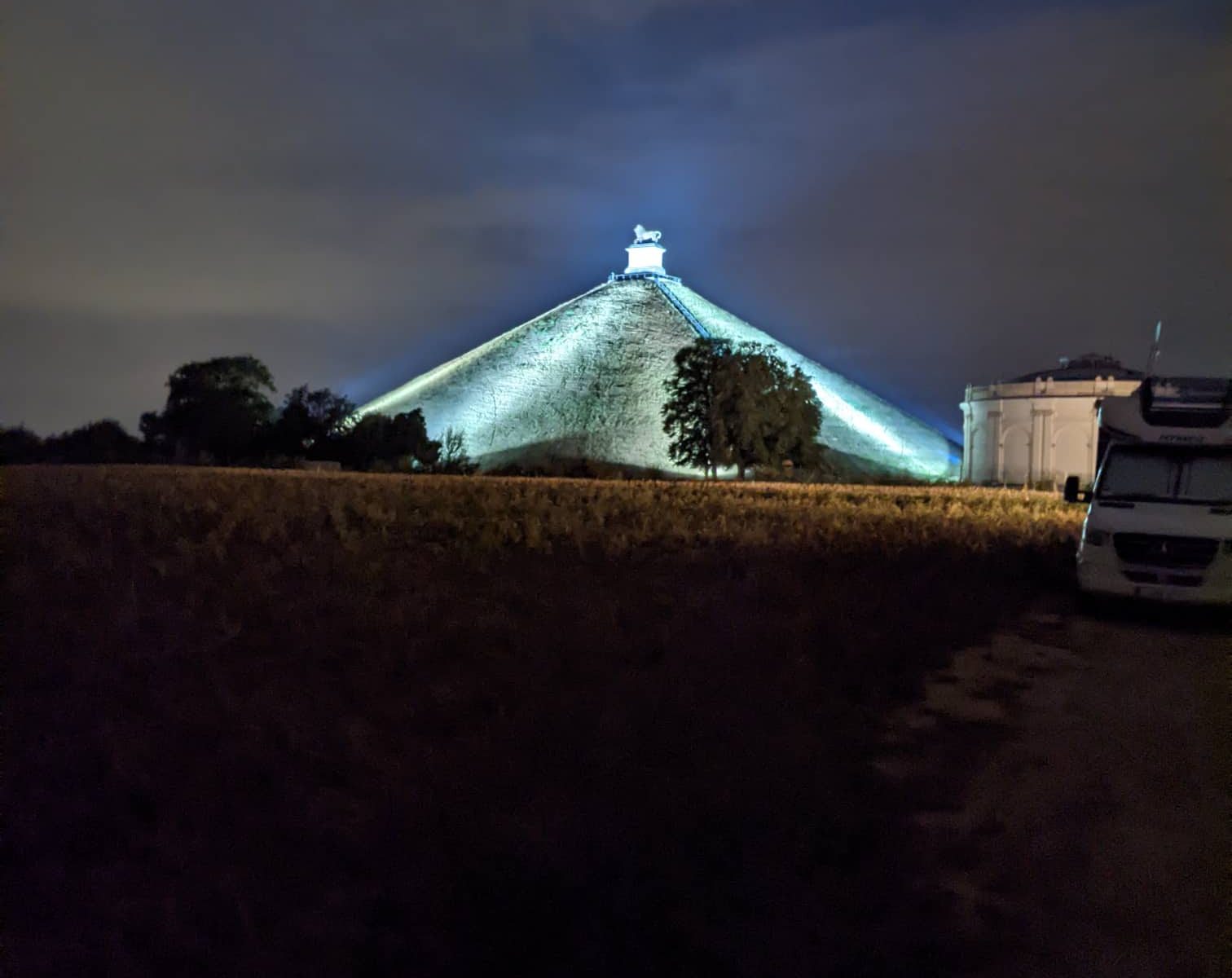
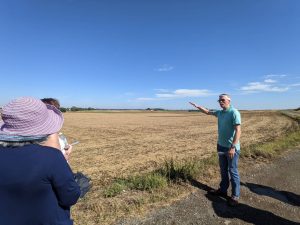
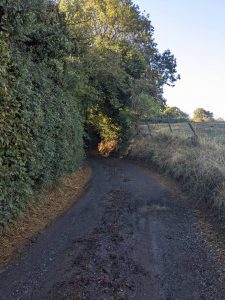 Number One London Tours
Number One London Tours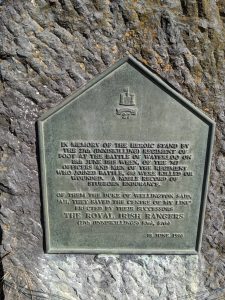 Features of the landscape like the covered way which is still partly visible, waist and head-high crops and surprisingly steep ridges help the story of the battle unfold far more easily than looking at maps. Gareth had maps a plenty though, to demonstrate each stage of the fighting as we reached it, starting from Papelotte and moving around the various parts of the field. He had also brought a copy of his fantastic
Features of the landscape like the covered way which is still partly visible, waist and head-high crops and surprisingly steep ridges help the story of the battle unfold far more easily than looking at maps. Gareth had maps a plenty though, to demonstrate each stage of the fighting as we reached it, starting from Papelotte and moving around the various parts of the field. He had also brought a copy of his fantastic Interspersed with clear, easy to understand descriptions of troop movements and the various attacks at different stages of the battle, were the individual stories from both Gareth and Kristine about the men who fought, suffered and died at Waterloo. I’ve seen many of these accounts before but hearing them read out on the ground where the action took place gave them a whole new meaning.
Interspersed with clear, easy to understand descriptions of troop movements and the various attacks at different stages of the battle, were the individual stories from both Gareth and Kristine about the men who fought, suffered and died at Waterloo. I’ve seen many of these accounts before but hearing them read out on the ground where the action took place gave them a whole new meaning.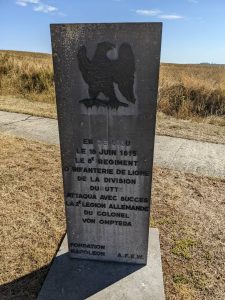 It was also horribly easy to imagine the aftermath, with dead and wounded strewn across the field. Injured men staggered towards anywhere they might find help and too many of them fell by the wayside. The memorials to the different armies and regiments as well as to a few individuals which are scattered around the battlefield highlight the poignant truth that most men who died at Waterloo had no marked grave, no memorial and quite possibly may not even have been buried at all.
It was also horribly easy to imagine the aftermath, with dead and wounded strewn across the field. Injured men staggered towards anywhere they might find help and too many of them fell by the wayside. The memorials to the different armies and regiments as well as to a few individuals which are scattered around the battlefield highlight the poignant truth that most men who died at Waterloo had no marked grave, no memorial and quite possibly may not even have been buried at all.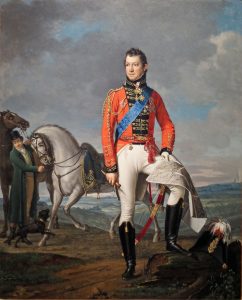
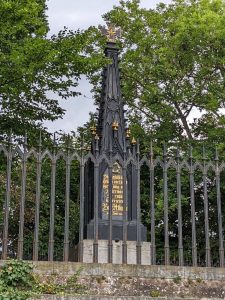
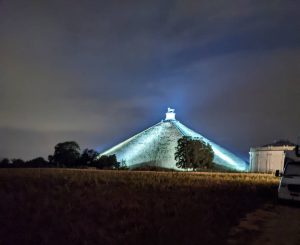 When we emerged, it was dark. Kristine had bought some flowers and a few of us walked up towards the Lion’s Mound which is lit up at night. It looked spectacular and despite all the jokes about it spoiling the battlefield, it felt like a fitting memorial that night, not to the Prince of Orange or Wellington or to any of the other individual commanders but to the thousands of anonymous men and animals who died on that field two hundred and seven years ago.
When we emerged, it was dark. Kristine had bought some flowers and a few of us walked up towards the Lion’s Mound which is lit up at night. It looked spectacular and despite all the jokes about it spoiling the battlefield, it felt like a fitting memorial that night, not to the Prince of Orange or Wellington or to any of the other individual commanders but to the thousands of anonymous men and animals who died on that field two hundred and seven years ago. 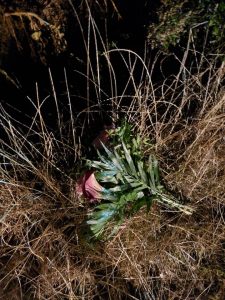 We placed the flowers on the edge of the field, not on any particular monument but just on a spot where any man might have fallen and stood quietly, listening on a phone to John Tams singing Spanish Ladies, a haunting folk song. A version of that song existed in 1815 and might have been sung by the campfires by men who did not survive that day. It seemed an appropriate memorial to the ordinary soldiers and the perfect way to end Waterloo 2022: the Battlefield Tour.
We placed the flowers on the edge of the field, not on any particular monument but just on a spot where any man might have fallen and stood quietly, listening on a phone to John Tams singing Spanish Ladies, a haunting folk song. A version of that song existed in 1815 and might have been sung by the campfires by men who did not survive that day. It seemed an appropriate memorial to the ordinary soldiers and the perfect way to end Waterloo 2022: the Battlefield Tour.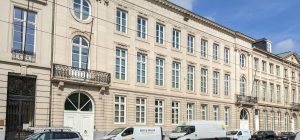
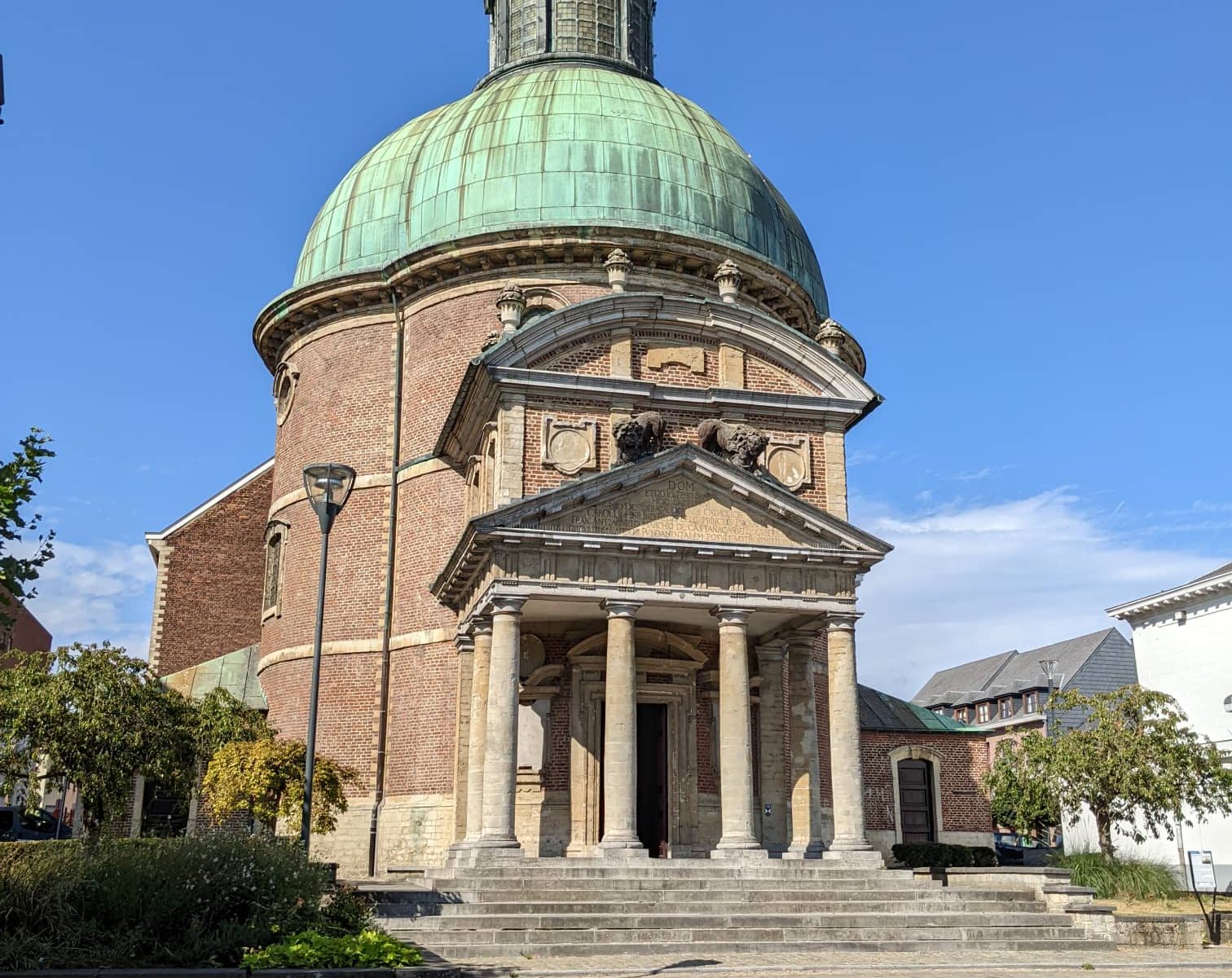
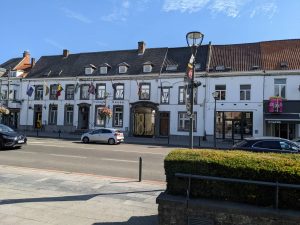
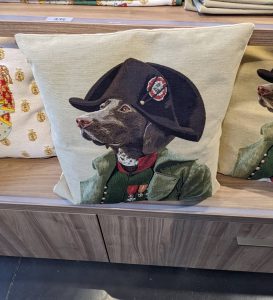 I have no idea whether there’s something political about this, whether it’s considered Napoleon was the most important person at Waterloo given that he was an Emperor or whether they just don’t think Wellington or Blucher memorabilia will sell. I do think it should probably be redressed, but if it’s a marketing decision then I guess that’s a good enough reason. All the same, Napoleon as a dog was a bit much for me.
I have no idea whether there’s something political about this, whether it’s considered Napoleon was the most important person at Waterloo given that he was an Emperor or whether they just don’t think Wellington or Blucher memorabilia will sell. I do think it should probably be redressed, but if it’s a marketing decision then I guess that’s a good enough reason. All the same, Napoleon as a dog was a bit much for me.
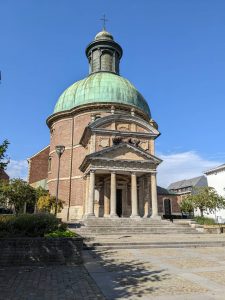 Across the busy road from the Wellington Museum is the elaborate church which was there at the time of the battle and used, like many churches, as a hospital to receive wounded men. Those of you who have followed me for a while know that I have a thing about old churches and this one was particularly peaceful, with a number of memorials to the men who fought and died during the Waterloo campaign. Memorials at this time tended to be paid for either by the family of the dead man or by subscription through the various battalions and regiments, so not surprisingly more of them relate to the wealthier regiments. Very few of the memorials even mention the NCOs and enlisted men apart from this one in the church, which may well be the first of its kind.
Across the busy road from the Wellington Museum is the elaborate church which was there at the time of the battle and used, like many churches, as a hospital to receive wounded men. Those of you who have followed me for a while know that I have a thing about old churches and this one was particularly peaceful, with a number of memorials to the men who fought and died during the Waterloo campaign. Memorials at this time tended to be paid for either by the family of the dead man or by subscription through the various battalions and regiments, so not surprisingly more of them relate to the wealthier regiments. Very few of the memorials even mention the NCOs and enlisted men apart from this one in the church, which may well be the first of its kind.
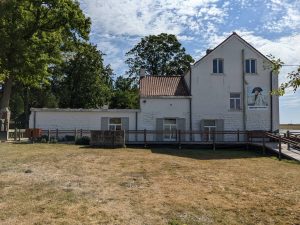 After lunch we moved on to Napoleon’s Headquarters in the farmhouse of Le Caillou, where Napoleon and his staff spent the night of June 17, 1815. The museum collection is spread over five rooms and tells the story of the Emperor’s actions in the hours before Waterloo. There are a number of artefacts relating to Napoleon, though Gareth queried whether some of the furniture was authentic given that the Prussians reputedly set fire to everything on their way through after Napoleon’s departure. Still, it gives a good sense of how the farm might have looked at the time.
After lunch we moved on to Napoleon’s Headquarters in the farmhouse of Le Caillou, where Napoleon and his staff spent the night of June 17, 1815. The museum collection is spread over five rooms and tells the story of the Emperor’s actions in the hours before Waterloo. There are a number of artefacts relating to Napoleon, though Gareth queried whether some of the furniture was authentic given that the Prussians reputedly set fire to everything on their way through after Napoleon’s departure. Still, it gives a good sense of how the farm might have looked at the time.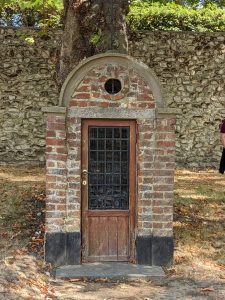 In the garden outside the farmhouse are one or two memorials. There is also an ossuary, which is a small building intended to serve as the final resting place of human bones. Ossuaries are often used where burial space is scarce but in this case it has become a depository for bones found on the battlefield over the years. I’ve seen photos of this but found the real thing unexpectedly moving.
In the garden outside the farmhouse are one or two memorials. There is also an ossuary, which is a small building intended to serve as the final resting place of human bones. Ossuaries are often used where burial space is scarce but in this case it has become a depository for bones found on the battlefield over the years. I’ve seen photos of this but found the real thing unexpectedly moving.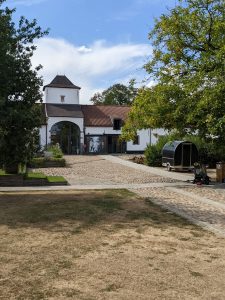
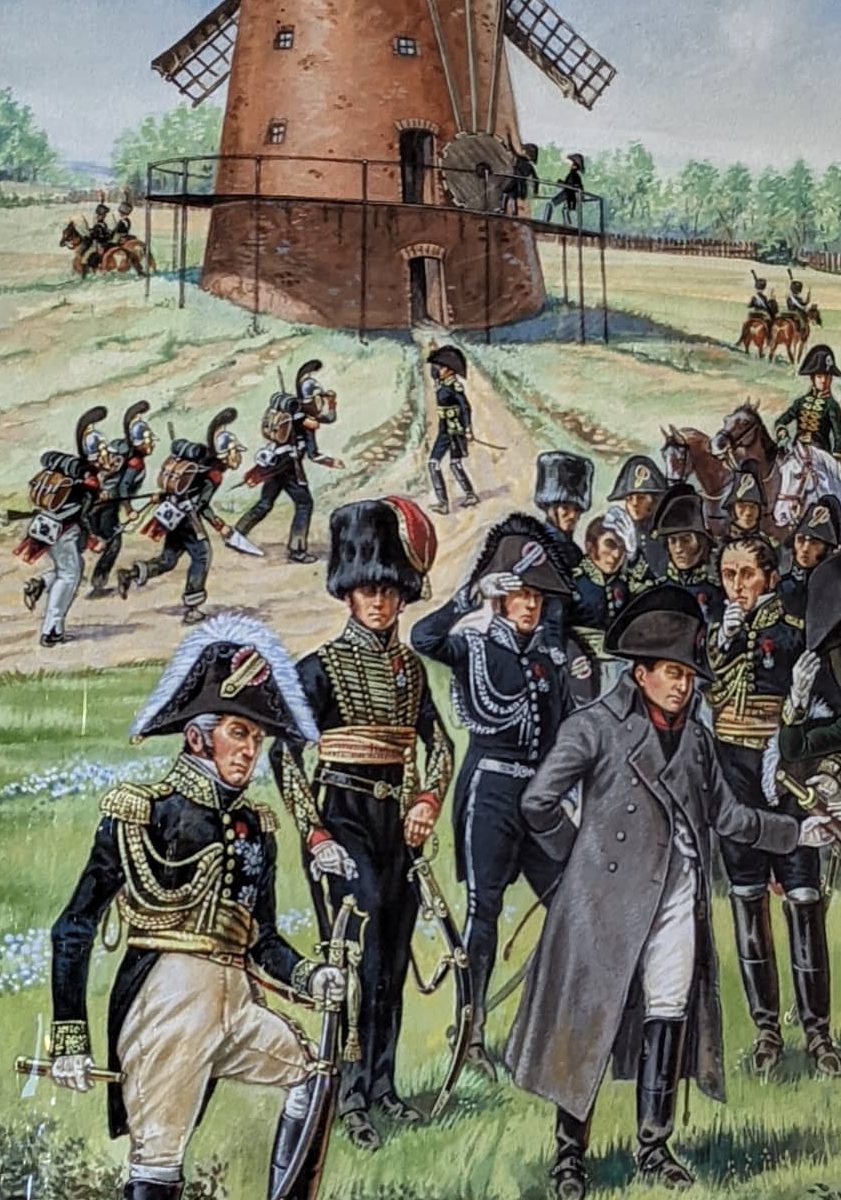

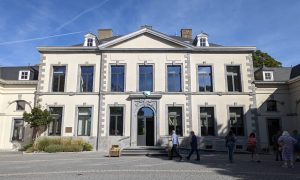
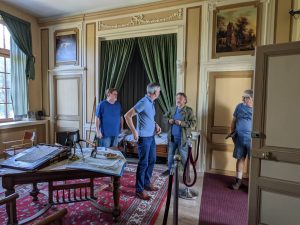
 Our next visit was to the small but very good museum in Ligny. It covers both Ligny and Quatre Bras and gave a very good sense of what happened on 16th June in these small villages and towns as the French inflicted a bloody defeat on Blucher’s Prussians and fought to a stalemate against Wellington’s Allied army. I was shocked at the extent of the casualties at both battles. Somehow I’d always had the vague impression that these were just skirmishes ahead of the main battle, but they clearly weren’t. All three armies were weakened by what happened on this day and it must have had an effect on what happened at Waterloo.
Our next visit was to the small but very good museum in Ligny. It covers both Ligny and Quatre Bras and gave a very good sense of what happened on 16th June in these small villages and towns as the French inflicted a bloody defeat on Blucher’s Prussians and fought to a stalemate against Wellington’s Allied army. I was shocked at the extent of the casualties at both battles. Somehow I’d always had the vague impression that these were just skirmishes ahead of the main battle, but they clearly weren’t. All three armies were weakened by what happened on this day and it must have had an effect on what happened at Waterloo.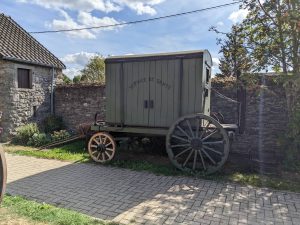
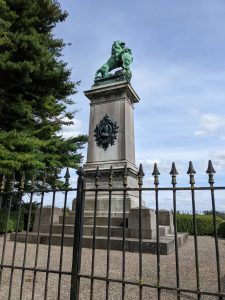
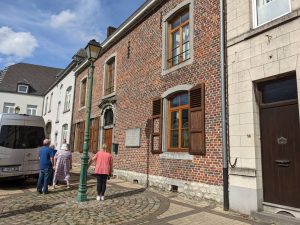
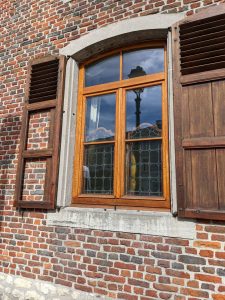
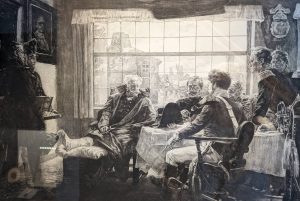
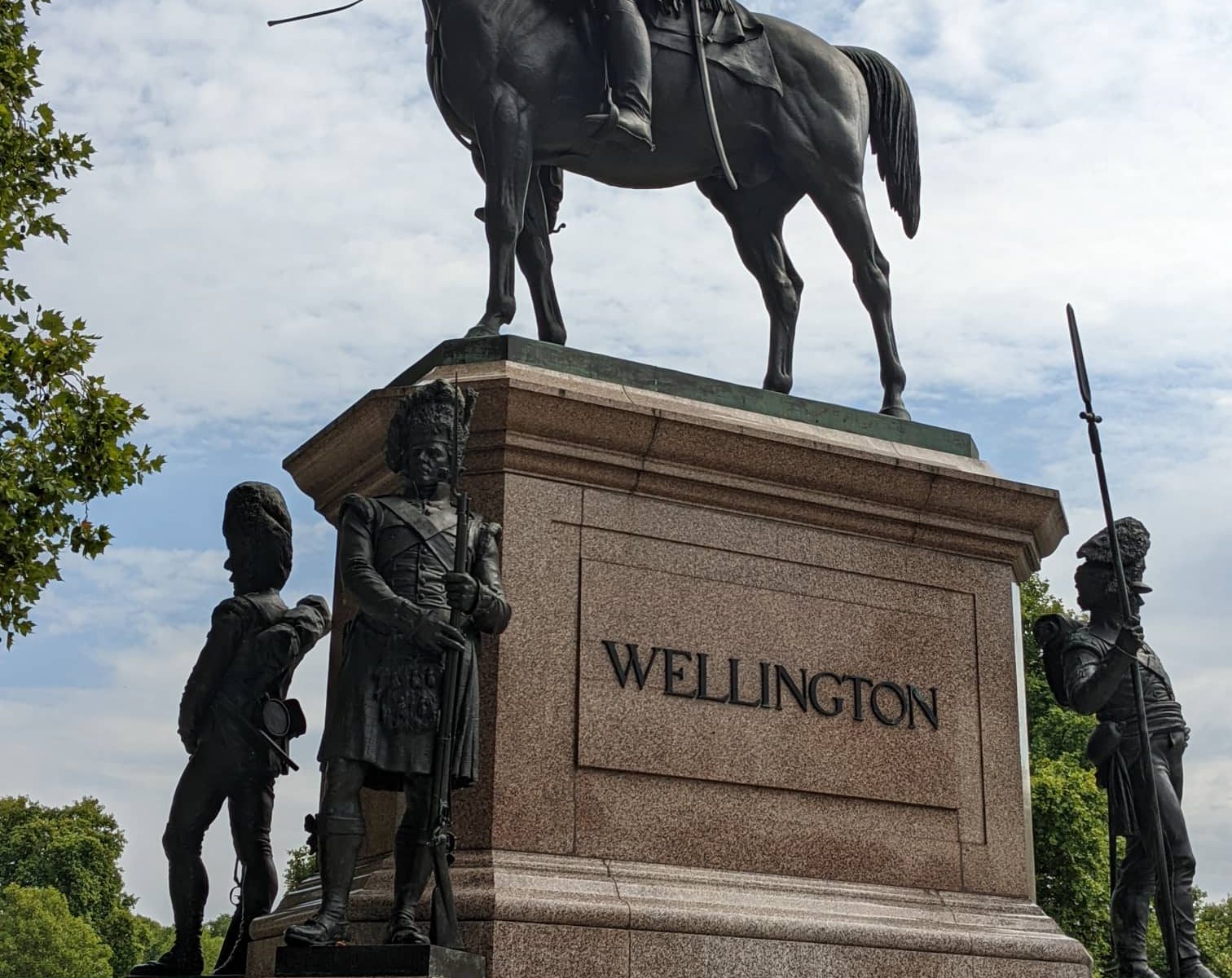
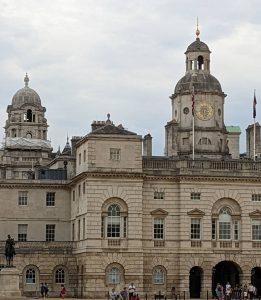
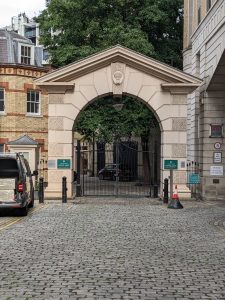
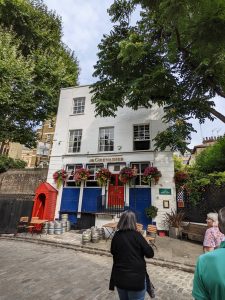
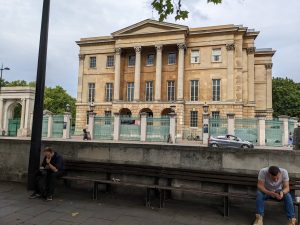
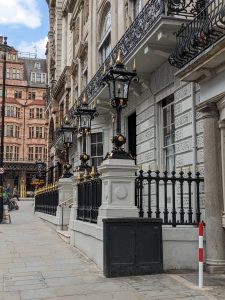
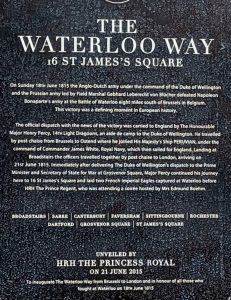
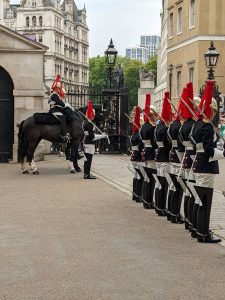 Our final stop for the day was the Horse Guards museum and were in time to see an inspection parade. After that it was back to the hotel in preparation for an early start on the Eurostar to Brussels the following morning.
Our final stop for the day was the Horse Guards museum and were in time to see an inspection parade. After that it was back to the hotel in preparation for an early start on the Eurostar to Brussels the following morning.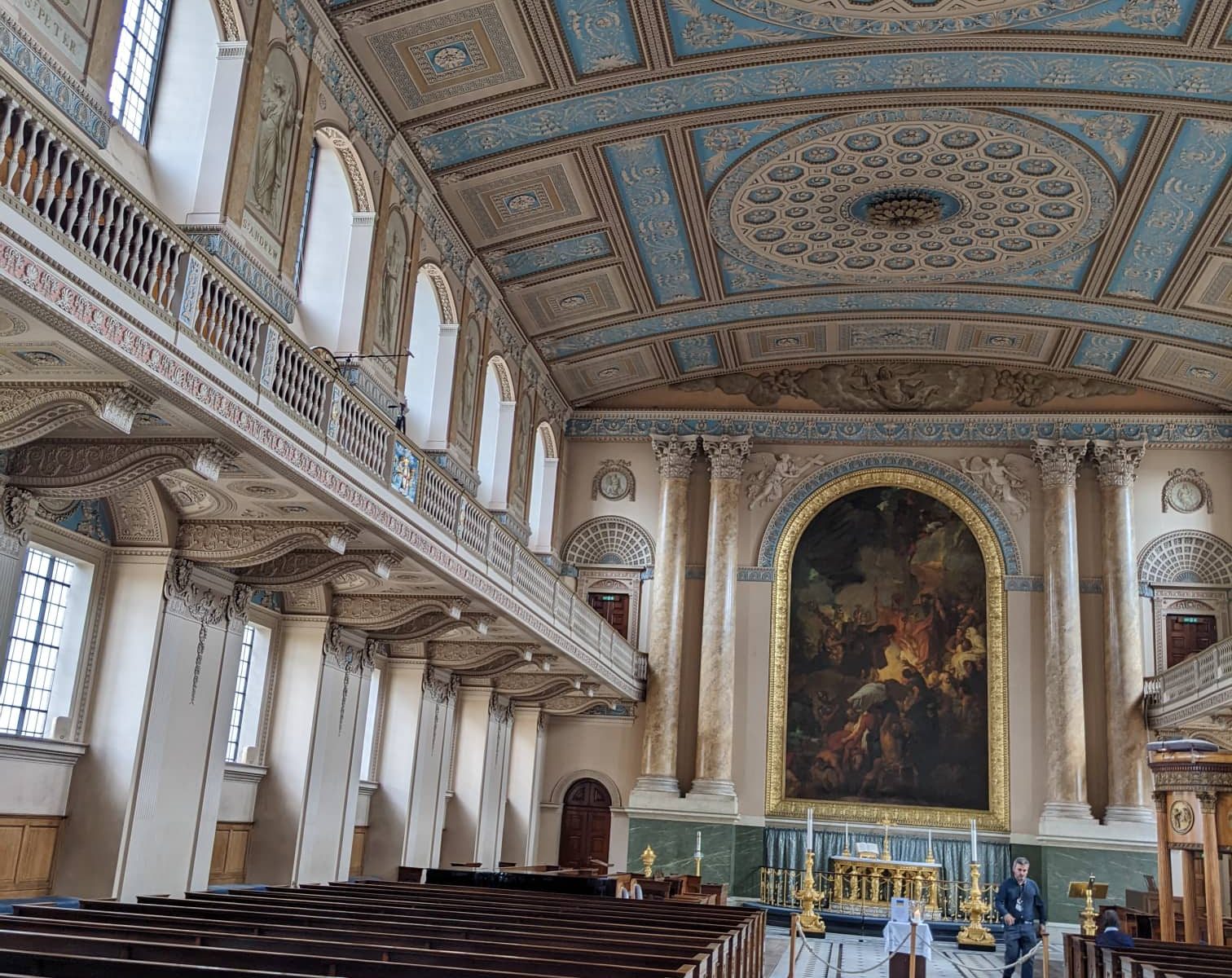
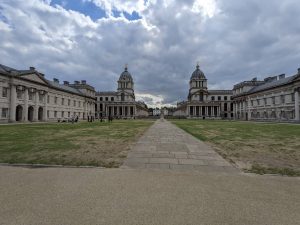 Waterloo 2022: prelude only really came about because I live on the Isle of Man. My much anticipated
Waterloo 2022: prelude only really came about because I live on the Isle of Man. My much anticipated 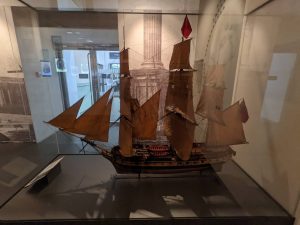 The
The 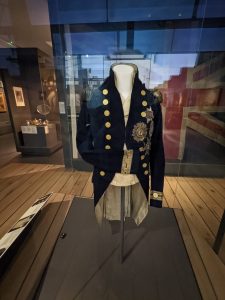 There is, as usual, an abundance of information and artefacts about Lord Nelson, England’s most feted naval hero including the clothing he was wearing when he was shot down on the deck of the Victory during the Battle of Trafalgar. While I’m grateful that the national obsession with Nelson means that EVERY navy museum has something relating to my period of interest, I can’t help imagining the howls of indignation of a few other navy officers of the era who really did some quite impressive stuff themselves, but don’t get a mention. Nevertheless, the National Maritime Museum is fascinating, with loads to see and do for both adults and children and I highly recommend it.
There is, as usual, an abundance of information and artefacts about Lord Nelson, England’s most feted naval hero including the clothing he was wearing when he was shot down on the deck of the Victory during the Battle of Trafalgar. While I’m grateful that the national obsession with Nelson means that EVERY navy museum has something relating to my period of interest, I can’t help imagining the howls of indignation of a few other navy officers of the era who really did some quite impressive stuff themselves, but don’t get a mention. Nevertheless, the National Maritime Museum is fascinating, with loads to see and do for both adults and children and I highly recommend it.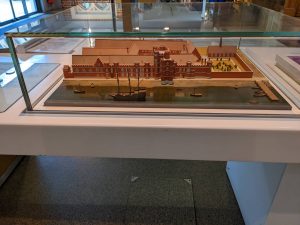
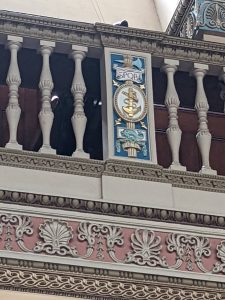 Greenwich Seaman’s Hospital was built on the orders of Mary II who was affected by the sight of wounded sailors coming home from the Battle of La Hogue. It is incredibly beautiful architecturally and both the Chapel and the Painted Hall are well worth a visit. I particularly liked the Chapel, which has naval motifs incorporated into the design.
Greenwich Seaman’s Hospital was built on the orders of Mary II who was affected by the sight of wounded sailors coming home from the Battle of La Hogue. It is incredibly beautiful architecturally and both the Chapel and the Painted Hall are well worth a visit. I particularly liked the Chapel, which has naval motifs incorporated into the design. 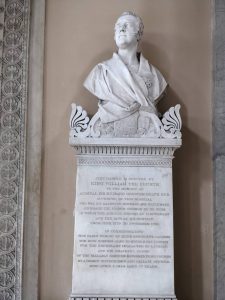
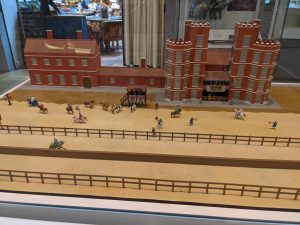
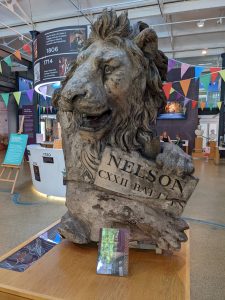 Nelson also features a fair bit, surprisingly enough. England’s Hero lay in state for several days in the Painted Hall and there is a small dedicated Nelson Room, but my favourite artefact is a lion which was apparently a model piece for the Nelson frieze. The lion is holding a stone which purports to claim that Nelson fought in 122 battles. I had this piece of information from the guide and I’ve not managed to check it at all, but my extensive reading on the subject of the Napoleonic navy so far has suggested that most of the time was spent either on tedious blockade duty or seething at home on half-pay. Nobody seemed able to answer my question about how Nelson managed to see quite so much action during his time in the navy but if I get to the bottom of it, I’ll let you know. Alternatively, if anybody else knows where I can find a list of these battles, I’d love to hear it. Nice lion, though.
Nelson also features a fair bit, surprisingly enough. England’s Hero lay in state for several days in the Painted Hall and there is a small dedicated Nelson Room, but my favourite artefact is a lion which was apparently a model piece for the Nelson frieze. The lion is holding a stone which purports to claim that Nelson fought in 122 battles. I had this piece of information from the guide and I’ve not managed to check it at all, but my extensive reading on the subject of the Napoleonic navy so far has suggested that most of the time was spent either on tedious blockade duty or seething at home on half-pay. Nobody seemed able to answer my question about how Nelson managed to see quite so much action during his time in the navy but if I get to the bottom of it, I’ll let you know. Alternatively, if anybody else knows where I can find a list of these battles, I’d love to hear it. Nice lion, though.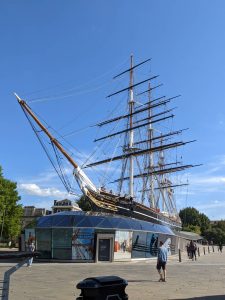 My final visit of the day was to the Cutty Sark, a nineteenth century tea clipper located in dry dock on the river bank. The Cutty Sark has a very sentimental place in my heart as it was a favourite place to visit as a child. We used to go to Greenwich a lot, getting the bus from Mile End and then walking through the Victorian foot tunnel under the river. I loved it there, the park and the eclectic market, the little shops, the Queen’s House and the Observatory, the graceful buildings of the Naval College. That much history in one place always set off my very eccentric imagination about the men and women who had lived in these buildings and walked these streets in the past. But the absolute joy for me was the once or twice a year when we were allowed to actually go aboard the Cutty Sark.
My final visit of the day was to the Cutty Sark, a nineteenth century tea clipper located in dry dock on the river bank. The Cutty Sark has a very sentimental place in my heart as it was a favourite place to visit as a child. We used to go to Greenwich a lot, getting the bus from Mile End and then walking through the Victorian foot tunnel under the river. I loved it there, the park and the eclectic market, the little shops, the Queen’s House and the Observatory, the graceful buildings of the Naval College. That much history in one place always set off my very eccentric imagination about the men and women who had lived in these buildings and walked these streets in the past. But the absolute joy for me was the once or twice a year when we were allowed to actually go aboard the Cutty Sark.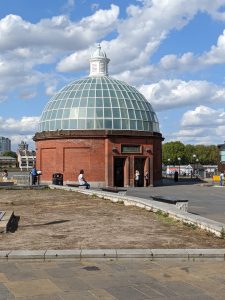
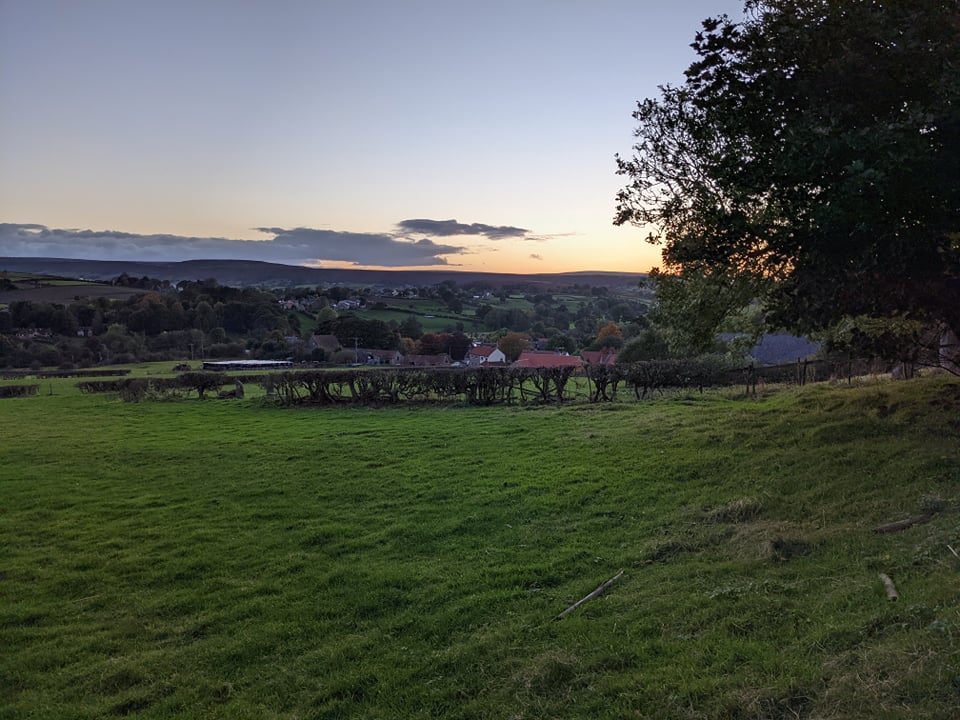
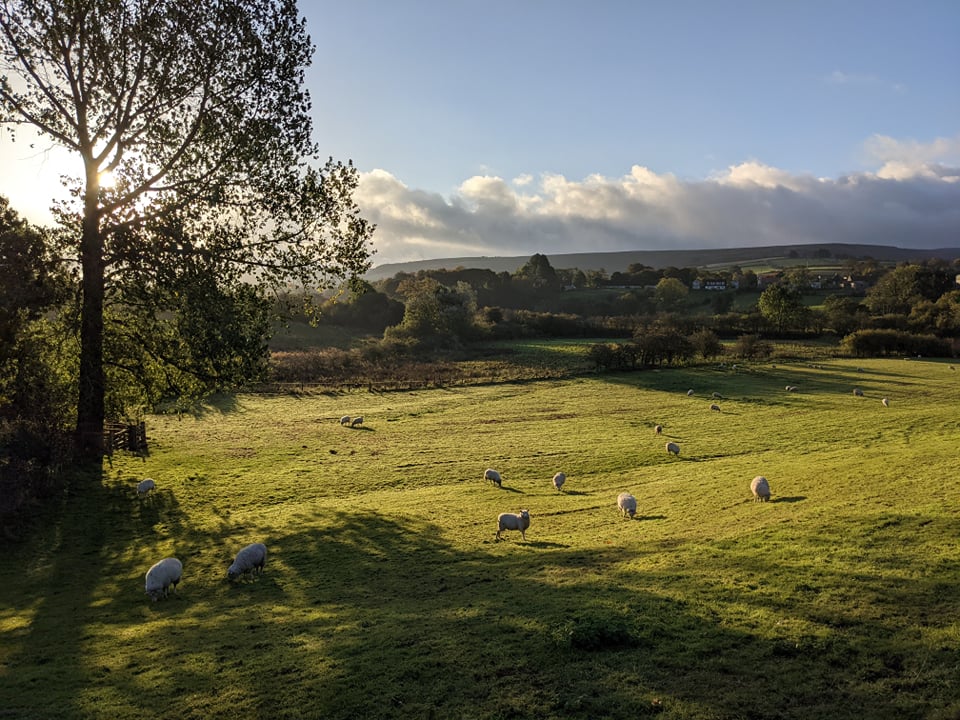
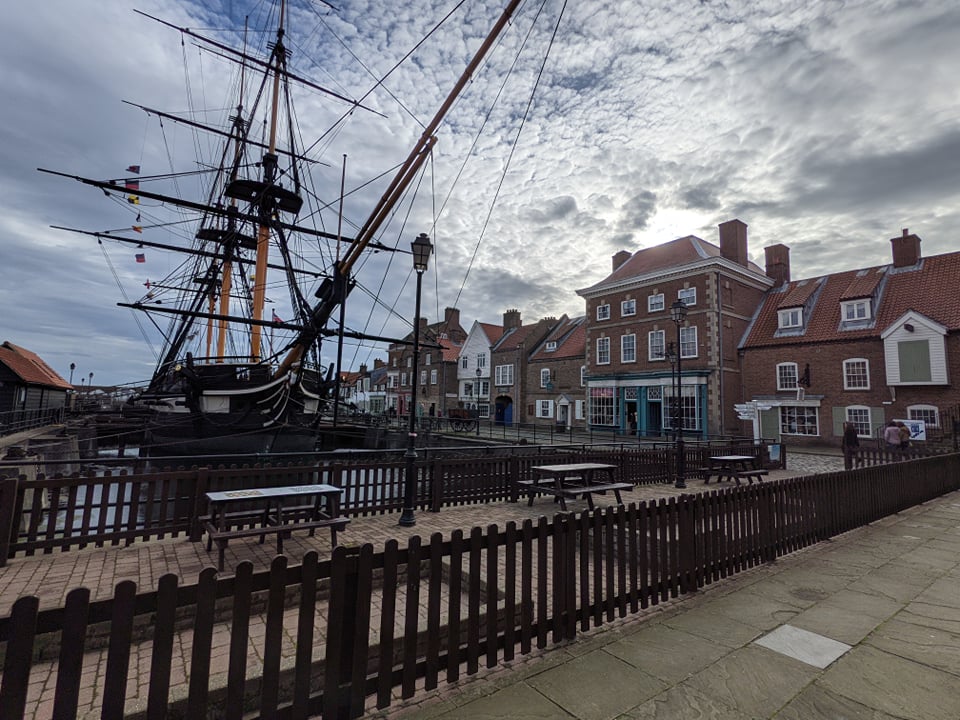
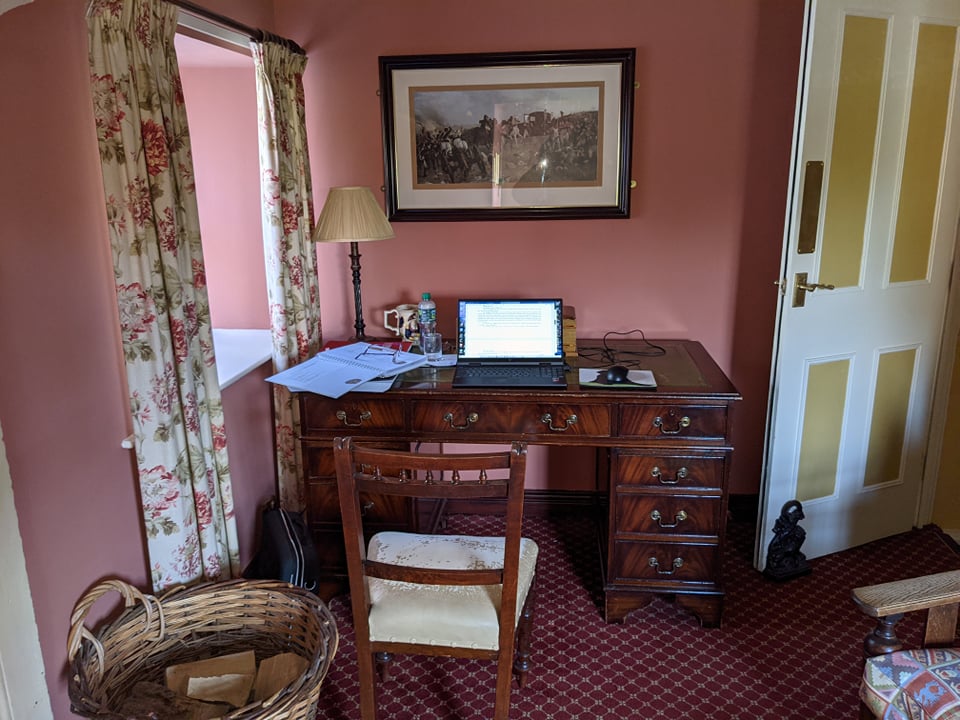 I checked with the owner whether there was a suitable table in my room for working. The single rooms were fairly small, but he assured me there was a guests’ sitting room with a desk in it and I’d be very welcome to work there as it was seldom used. When I arrived and saw it, I couldn’t quite believe my luck. For a week, I effectively had my own personal study. It was completely lovely.
I checked with the owner whether there was a suitable table in my room for working. The single rooms were fairly small, but he assured me there was a guests’ sitting room with a desk in it and I’d be very welcome to work there as it was seldom used. When I arrived and saw it, I couldn’t quite believe my luck. For a week, I effectively had my own personal study. It was completely lovely.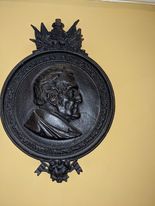 A cast iron plaque of the Duke was unearthed during restoration work and can be seen on the wall as you go up the stairs. The inn is not large and is very obviously old – floors are uneven and the furniture is very traditional. Impressively, though, all the essential things for a comfortable stay work really well – the bed was comfortable, the bathroom modern and heating and hot water were spot on. I’d booked bed and breakfast, but after a look at the dinner menu, decided I’d eat there in the evening as well. It was standard pub food, but well-cooked and sensibly priced, and I never object to sitting by an open fire in a traditional country pub to eat. In addition, the staff were absolutely amazing. Nothing was too much trouble and they treated my invasion of the guest sitting room as though it was the most normal thing in the world. Thank you so much guys.
A cast iron plaque of the Duke was unearthed during restoration work and can be seen on the wall as you go up the stairs. The inn is not large and is very obviously old – floors are uneven and the furniture is very traditional. Impressively, though, all the essential things for a comfortable stay work really well – the bed was comfortable, the bathroom modern and heating and hot water were spot on. I’d booked bed and breakfast, but after a look at the dinner menu, decided I’d eat there in the evening as well. It was standard pub food, but well-cooked and sensibly priced, and I never object to sitting by an open fire in a traditional country pub to eat. In addition, the staff were absolutely amazing. Nothing was too much trouble and they treated my invasion of the guest sitting room as though it was the most normal thing in the world. Thank you so much guys. I’m pleased to say I stood by my resolution to treat this week as a writer’s retreat. Apart from my one excursion to Hartlepool, I remained in and around the village. The weather was beautiful, crisp and cold but with only one rainy day. I ordered breakfast early then went for a walk every morning before sitting down to work. Lunch was soup and sandwiches from the
I’m pleased to say I stood by my resolution to treat this week as a writer’s retreat. Apart from my one excursion to Hartlepool, I remained in and around the village. The weather was beautiful, crisp and cold but with only one rainy day. I ordered breakfast early then went for a walk every morning before sitting down to work. Lunch was soup and sandwiches from the 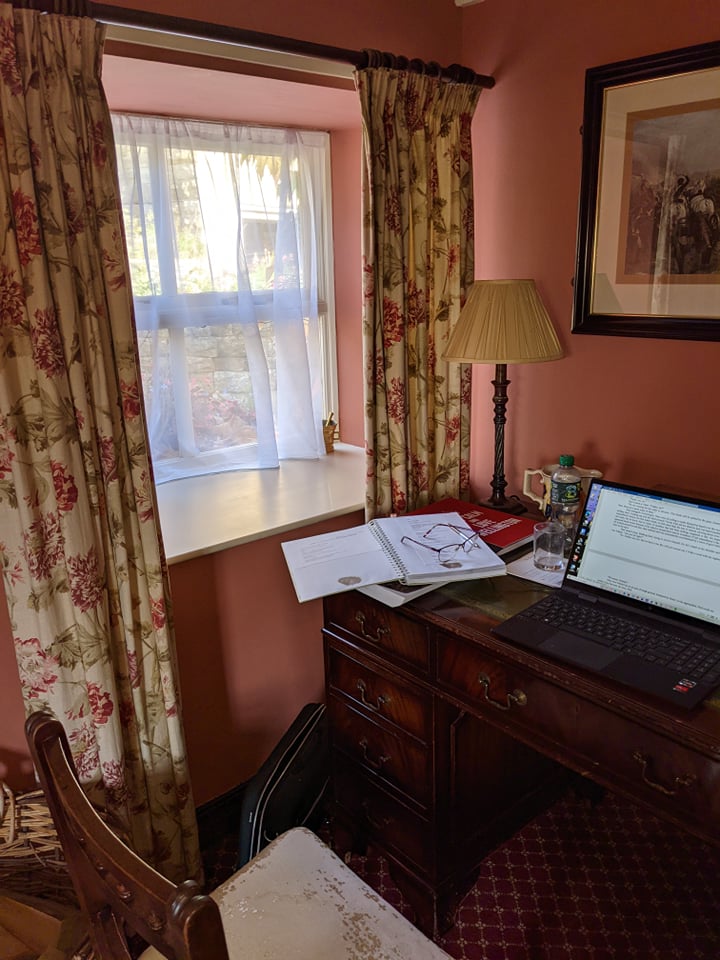 During the day I took over the desk and worked solidly on book seven, An Indomitable Brigade. I found, to my joy, that I’d been right about the book. There was nothing wrong with either plotting or the research I’d done. I just needed time, and peace and quiet to get on with it. I kept in touch with my family during the evening, but firmly refused to take calls during the day. I was helped by the fact that the wi-fi was variable. It worked very well in my room, and down in the bar areas but in the study it was patchy, which removed the temptation to chat on Twitter or Facebook. After the first day, I was completely absorbed in the world of the 110th and the battle of Vitoria.
During the day I took over the desk and worked solidly on book seven, An Indomitable Brigade. I found, to my joy, that I’d been right about the book. There was nothing wrong with either plotting or the research I’d done. I just needed time, and peace and quiet to get on with it. I kept in touch with my family during the evening, but firmly refused to take calls during the day. I was helped by the fact that the wi-fi was variable. It worked very well in my room, and down in the bar areas but in the study it was patchy, which removed the temptation to chat on Twitter or Facebook. After the first day, I was completely absorbed in the world of the 110th and the battle of Vitoria.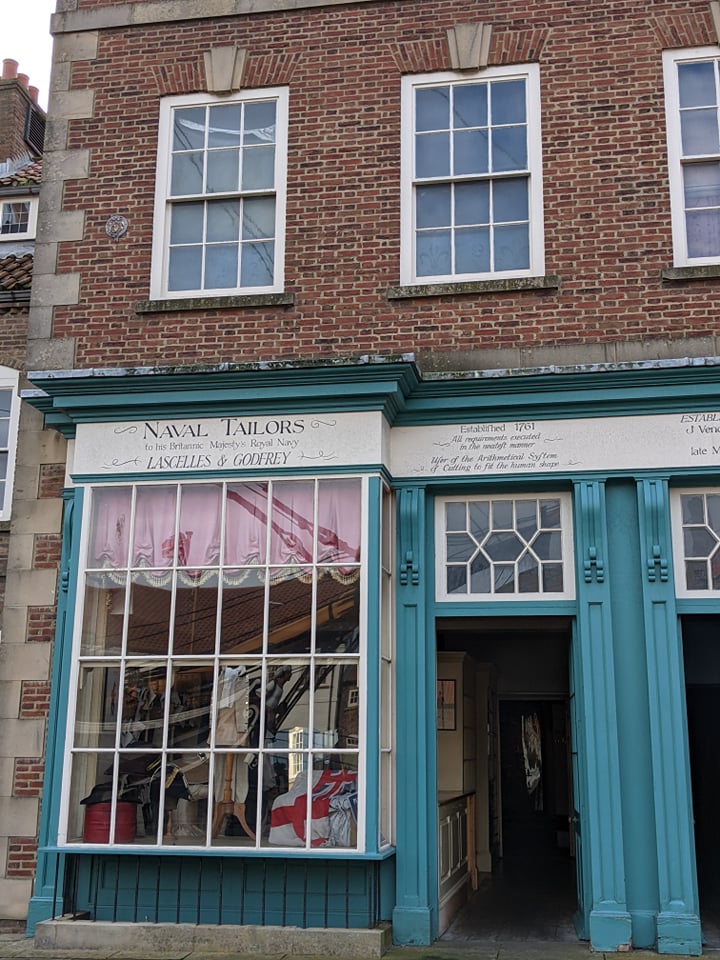 I enjoyed my day out at the National Museum of the Royal Navy in Hartlepool, and the Trincomalee was everything I hoped for and more. The museum is set up around a historic quayside restored to look like an eighteenth century seaport and its beautiful waterside setting. The various buildings are set up to show tradesmen like tailors, printers and instrument makers with stories about the Royal Navy and the men and women associated with it. It’s a great place for kids, with an adventure play ship and loads of activities, and because I was there during half term, there were demonstrations of gunnery and swordsmanship and various talks scheduled through the day. I went to everything, even though most of this wasn’t new to me. It was a great atmosphere, and I thoroughly enjoyed the interactive Fighting Sail exhibition, though the kids commentary around me probably entertained me as much as the displays.
I enjoyed my day out at the National Museum of the Royal Navy in Hartlepool, and the Trincomalee was everything I hoped for and more. The museum is set up around a historic quayside restored to look like an eighteenth century seaport and its beautiful waterside setting. The various buildings are set up to show tradesmen like tailors, printers and instrument makers with stories about the Royal Navy and the men and women associated with it. It’s a great place for kids, with an adventure play ship and loads of activities, and because I was there during half term, there were demonstrations of gunnery and swordsmanship and various talks scheduled through the day. I went to everything, even though most of this wasn’t new to me. It was a great atmosphere, and I thoroughly enjoyed the interactive Fighting Sail exhibition, though the kids commentary around me probably entertained me as much as the displays.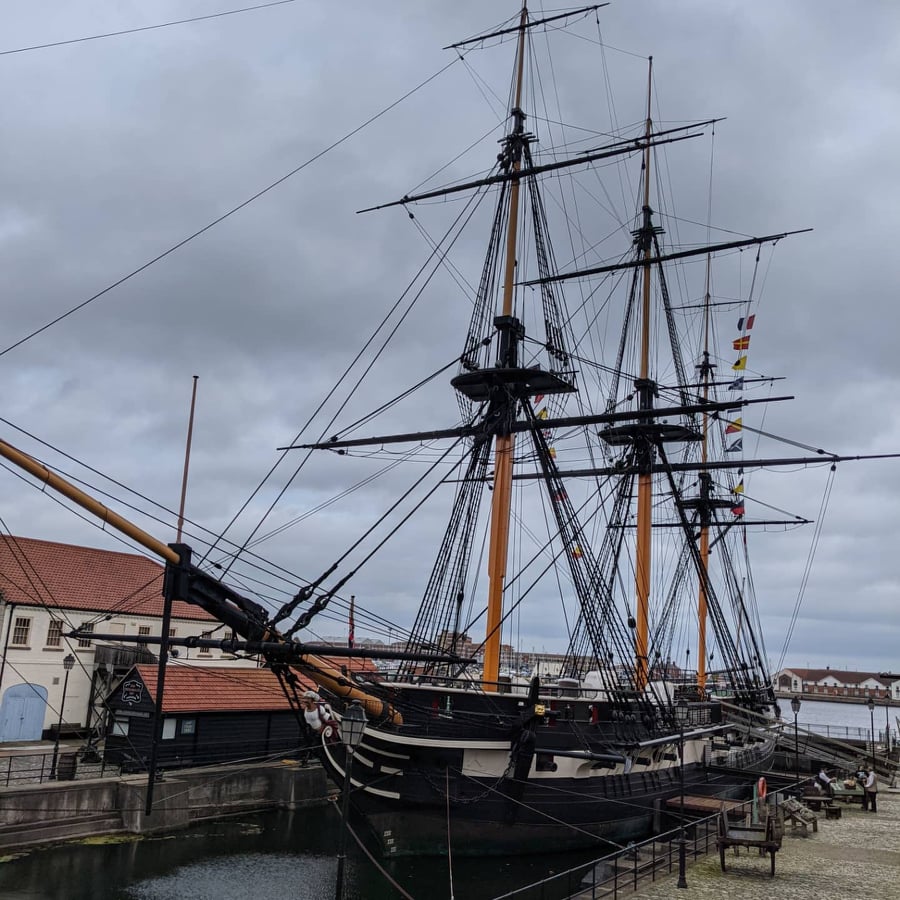 The Trincomalee was perfect, one of two surviving British frigates of her era. The other, HMS Unicorn is a museum ship in Dundee and I’m going to get there when I can. The Trincomalee was commissioned in 1812 to be built in India using teak, due to the shortage of oak in Britain after the intensive shipbuilding of the Napoleonic wars. Work did not begin until 1816 so by the time the ship was finished the following year, the wars were over and Trincomalee was put to other uses.
The Trincomalee was perfect, one of two surviving British frigates of her era. The other, HMS Unicorn is a museum ship in Dundee and I’m going to get there when I can. The Trincomalee was commissioned in 1812 to be built in India using teak, due to the shortage of oak in Britain after the intensive shipbuilding of the Napoleonic wars. Work did not begin until 1816 so by the time the ship was finished the following year, the wars were over and Trincomalee was put to other uses.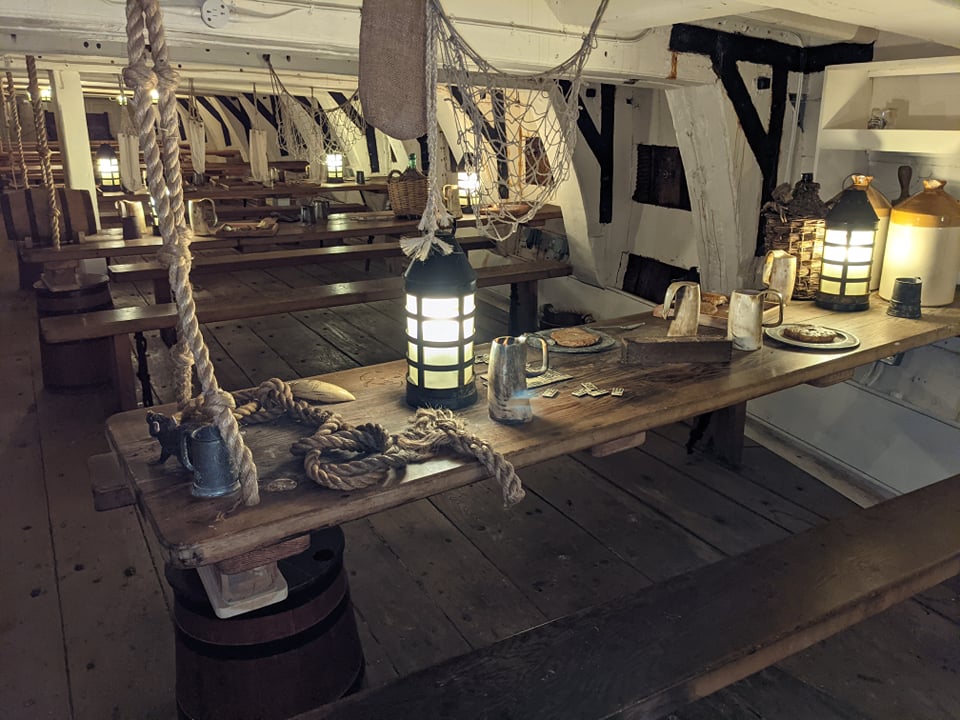 On the advice of one of the guides, I waited until the kids were completely absorbed in learning how to form a boarding party on the quayside using foam swords and cutlasses before boarding the ship. It was completely empty and I was able to take photographs, absorb the atmosphere and write stories in my head to my hearts content. The Trincomalee quickly morphed into the fictional Herne in my imagination, Hugh Kelly’s first post-command, and the story was finished. I’ll definitely come back to it though, I’d like to write a lot more of Hugh’s earlier adventures in the navy.
On the advice of one of the guides, I waited until the kids were completely absorbed in learning how to form a boarding party on the quayside using foam swords and cutlasses before boarding the ship. It was completely empty and I was able to take photographs, absorb the atmosphere and write stories in my head to my hearts content. The Trincomalee quickly morphed into the fictional Herne in my imagination, Hugh Kelly’s first post-command, and the story was finished. I’ll definitely come back to it though, I’d like to write a lot more of Hugh’s earlier adventures in the navy.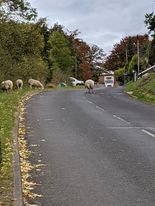
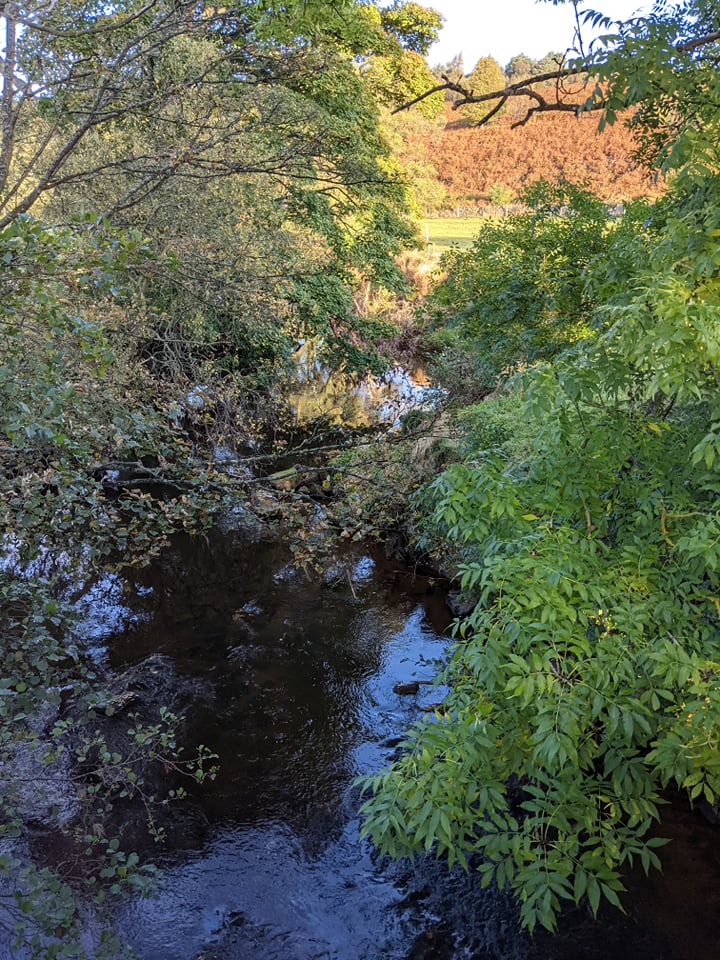 I’ve concluded that a writer’s retreat means different things to different people. For some, it’s about learning, and they’re looking for lectures and workshops and the ability to try something new. For others, it’s about connecting with other writers to share ideas and stories and to feel part of a community for a while, in this very solitary job that we do. For me, it’s definitely a retreat, a place of quiet and solitude and some beauty, where I can throw myself back into what I do best without any nagging sense of all the other things on my to do list.
I’ve concluded that a writer’s retreat means different things to different people. For some, it’s about learning, and they’re looking for lectures and workshops and the ability to try something new. For others, it’s about connecting with other writers to share ideas and stories and to feel part of a community for a while, in this very solitary job that we do. For me, it’s definitely a retreat, a place of quiet and solitude and some beauty, where I can throw myself back into what I do best without any nagging sense of all the other things on my to do list.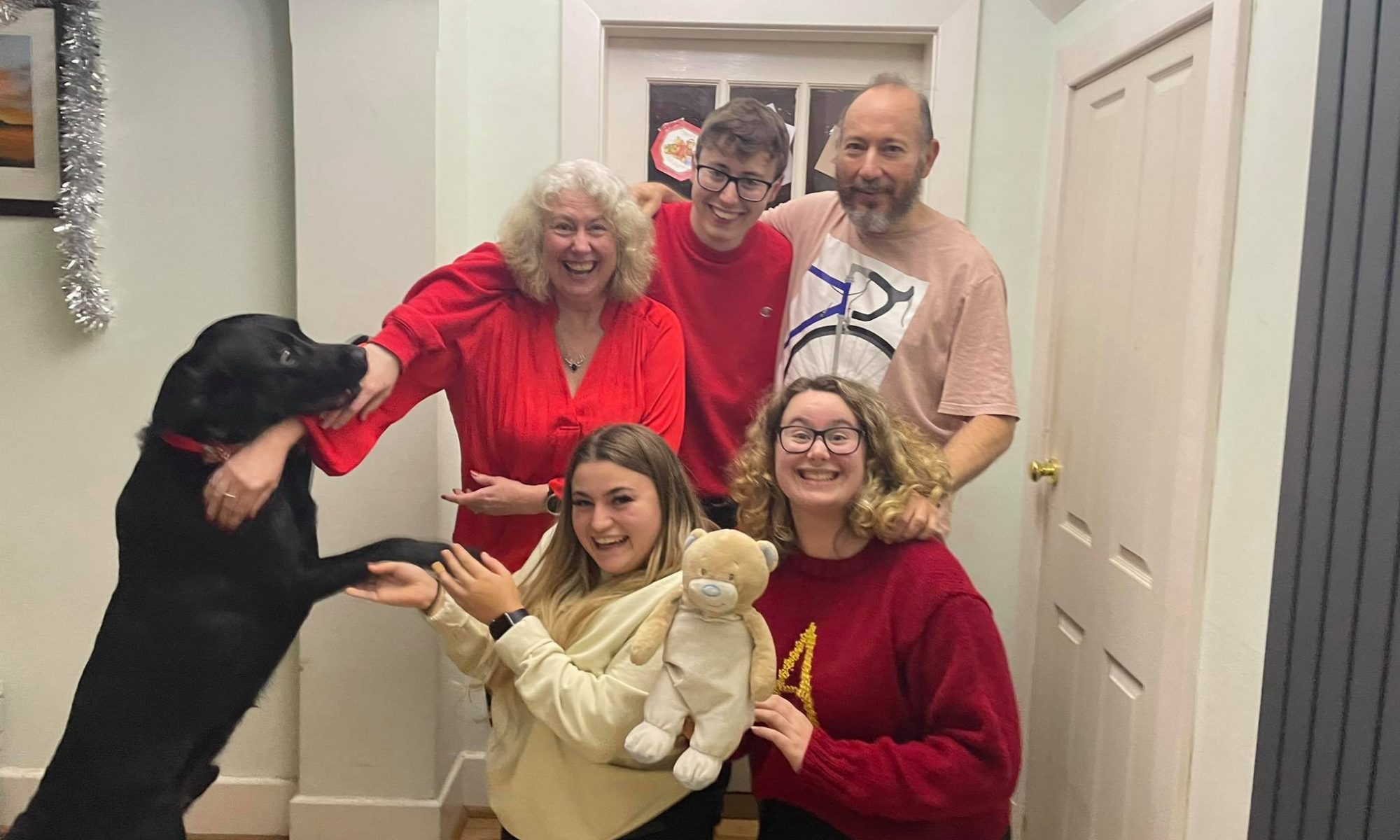

 I don’t bother to argue with Oscar. He’s so active that the odd day without a long walk doesn’t hurt him. I’m not so keen myself today either. I had a poor night last night and after a reasonably productive day work wise I hit a serious afternoon slump at about ten to four. I’ve officially given up now and I’ve lit the fire and am dozing on the sofa with Oscar as I’m not cooking tonight.
I don’t bother to argue with Oscar. He’s so active that the odd day without a long walk doesn’t hurt him. I’m not so keen myself today either. I had a poor night last night and after a reasonably productive day work wise I hit a serious afternoon slump at about ten to four. I’ve officially given up now and I’ve lit the fire and am dozing on the sofa with Oscar as I’m not cooking tonight. I’ve almost finished chapter two today. I don’t yet have a sense of how long this book is likely to be. My last couple were fairly long, but the Tarragona campaign itself was very short. Still, there are several plotlines running through it. More to the point, I will actually get to spend a bit more time at sea during this book. Both my previous naval books have been joint campaigns featuring both the army and the navy, but this one is purely from the naval point of view, so I’m doing a lot of background reading. Oscar is doing less background reading and more snoring, but he seems happy.
I’ve almost finished chapter two today. I don’t yet have a sense of how long this book is likely to be. My last couple were fairly long, but the Tarragona campaign itself was very short. Still, there are several plotlines running through it. More to the point, I will actually get to spend a bit more time at sea during this book. Both my previous naval books have been joint campaigns featuring both the army and the navy, but this one is purely from the naval point of view, so I’m doing a lot of background reading. Oscar is doing less background reading and more snoring, but he seems happy.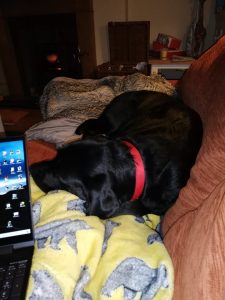 “I’d be a lot happier if you’d move that laptop, Mum. That clicking is disturbing me.”
“I’d be a lot happier if you’d move that laptop, Mum. That clicking is disturbing me.” Evenings are nice, though. Generally, we have a tendency to drift off to do our own thing, but without the social aspect of work or seeing friends, our youngsters are more inclined to hang around the kitchen or living room watching TV, playing games or just listening to music. I’ve heard a few parents with teenage or adult kids saying the same. Ours are quite lovely generally, but very busy, so this is a bit of an oasis.
Evenings are nice, though. Generally, we have a tendency to drift off to do our own thing, but without the social aspect of work or seeing friends, our youngsters are more inclined to hang around the kitchen or living room watching TV, playing games or just listening to music. I’ve heard a few parents with teenage or adult kids saying the same. Ours are quite lovely generally, but very busy, so this is a bit of an oasis. 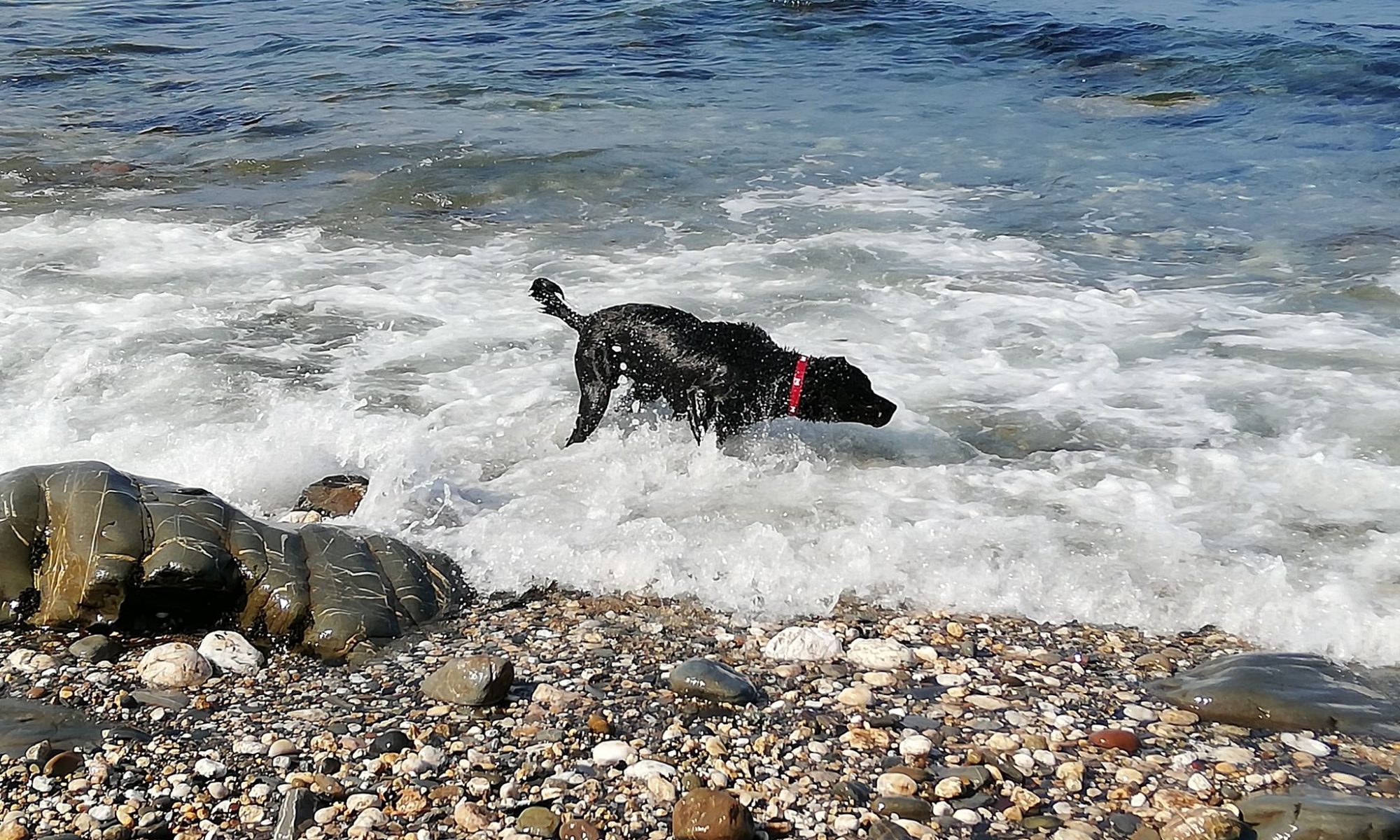
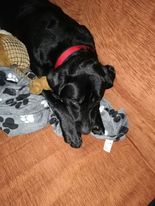 It’s Sunday, and after a wild night of compulsory Beer Pong with some of the younger members of the household, neither Oscar and I are up for an early start.
It’s Sunday, and after a wild night of compulsory Beer Pong with some of the younger members of the household, neither Oscar and I are up for an early start.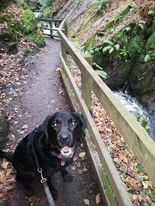 It’s quite a nice afternoon, so Oscar and I take the car and head up to
It’s quite a nice afternoon, so Oscar and I take the car and head up to 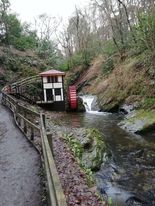 It’s the first time I’ve been down the glen since the old Victorian water wheel was back in place. It was removed for restoration, and it’s lovely to see it back, looking splendid. Oscar was very interested, but the water is very fast here, with a series of rapids, so we moved on to shallower parts before I let him off the lead to play in the water. He loves it, and will just run up and down in the river for the sheer joy of it.
It’s the first time I’ve been down the glen since the old Victorian water wheel was back in place. It was removed for restoration, and it’s lovely to see it back, looking splendid. Oscar was very interested, but the water is very fast here, with a series of rapids, so we moved on to shallower parts before I let him off the lead to play in the water. He loves it, and will just run up and down in the river for the sheer joy of it. Meet Moz. I didn’t get too many details about him, as we had to socially distance, but he was lovely. His owners and I took turns to throw sticks in the water and Oscar and Moz chased them. It was a lot of fun. At one point they were actually swimming while holding the stick between them, which reminded me of Toby and Joey. I wish I’d got better photos, but they didn’t keep still for long enough.
Meet Moz. I didn’t get too many details about him, as we had to socially distance, but he was lovely. His owners and I took turns to throw sticks in the water and Oscar and Moz chased them. It was a lot of fun. At one point they were actually swimming while holding the stick between them, which reminded me of Toby and Joey. I wish I’d got better photos, but they didn’t keep still for long enough.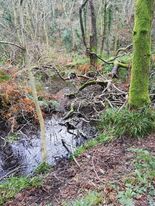 “Because that area is pure bog, and if you run into it, you might get stuck. When Toby was young, before we even had Joey, he took a flying leap into there thinking it was solid ground, and couldn’t get out.”
“Because that area is pure bog, and if you run into it, you might get stuck. When Toby was young, before we even had Joey, he took a flying leap into there thinking it was solid ground, and couldn’t get out.”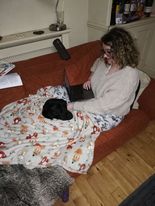 “It looks as though you are, Oscar. Sweet dreams.”
“It looks as though you are, Oscar. Sweet dreams.”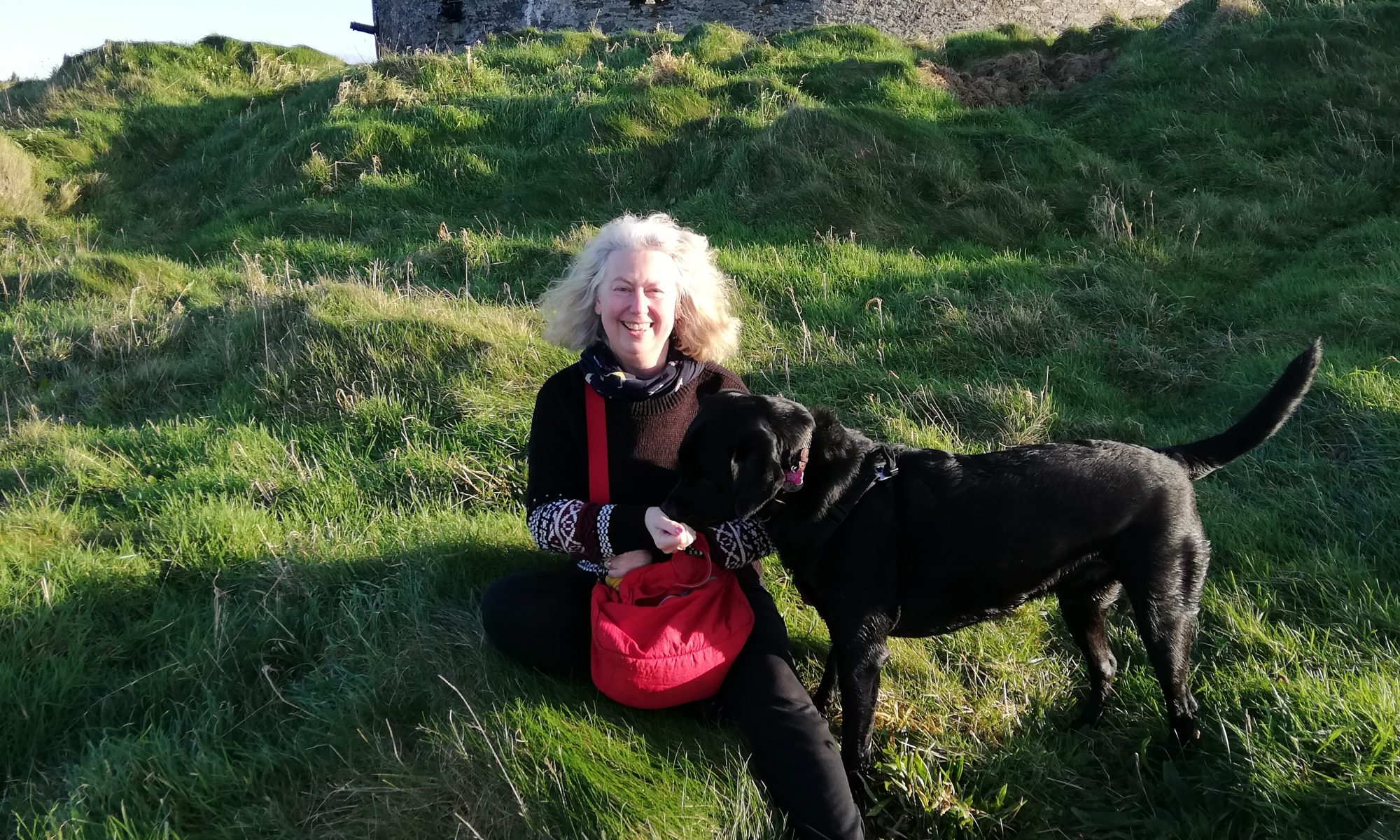
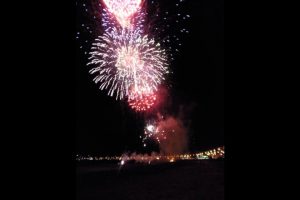
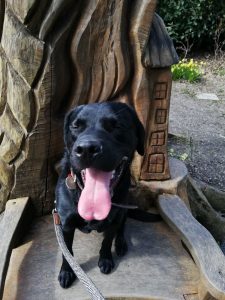 What 2020 has confirmed for me is that there are people out there whom I’ve met both online and in person, who are simply great. They come together both online and in person, drawn by a love of reading, writing, history and good fun. They’re excited by new books, new ideas and photographs of cuddly Labradors. They speak to each other with respect and affection and acknowledge their differences with humour and tolerance. They are not all the same. Some are highly educated and well-respected in their field. Others are self-educated and come to the discussion full of questions, often bringing new ideas. The thing that they all have in common is an enthusiasm for learning about people both fictional and in real life. They are entertaining, they are generous with their time and knowledge and they are kind.
What 2020 has confirmed for me is that there are people out there whom I’ve met both online and in person, who are simply great. They come together both online and in person, drawn by a love of reading, writing, history and good fun. They’re excited by new books, new ideas and photographs of cuddly Labradors. They speak to each other with respect and affection and acknowledge their differences with humour and tolerance. They are not all the same. Some are highly educated and well-respected in their field. Others are self-educated and come to the discussion full of questions, often bringing new ideas. The thing that they all have in common is an enthusiasm for learning about people both fictional and in real life. They are entertaining, they are generous with their time and knowledge and they are kind.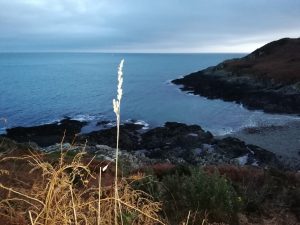
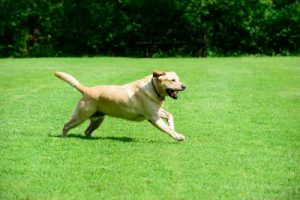 It took a long time to adjust to the loss of Joey, and it still catches me every now and again. Oscar has proved a worthy successor to my two old fellas, and when we can find a suitable puppy, we’ll be bringing in reinforcements for him on the staff of Writing with Labradors. I can’t wait.
It took a long time to adjust to the loss of Joey, and it still catches me every now and again. Oscar has proved a worthy successor to my two old fellas, and when we can find a suitable puppy, we’ll be bringing in reinforcements for him on the staff of Writing with Labradors. I can’t wait.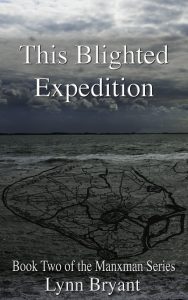 Professionally, it’s been my most successful year to date, although the stress of the first lockdown and the pandemic generally definitely slowed my writing down a lot. Sales have been good, and reviews have been excellent. For the second year in a row, I had a book shortlisted for the Society for Army Historical Research fiction prize, this year with
Professionally, it’s been my most successful year to date, although the stress of the first lockdown and the pandemic generally definitely slowed my writing down a lot. Sales have been good, and reviews have been excellent. For the second year in a row, I had a book shortlisted for the Society for Army Historical Research fiction prize, this year with 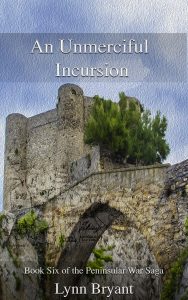 I completed and published book six of the Peninsular War Saga, An Unmerciful Incursion. I’ve begun research and planning for two new books. I also found a new editor, who is oddly enough an old friend of mine, and who is working out brilliantly so far.
I completed and published book six of the Peninsular War Saga, An Unmerciful Incursion. I’ve begun research and planning for two new books. I also found a new editor, who is oddly enough an old friend of mine, and who is working out brilliantly so far. Happy New Year from Writing with Labradors for 2021. I hope you’ll all manage to celebrate in whatever way you can, and I look forward to hearing a lot more from you all in the coming year.
Happy New Year from Writing with Labradors for 2021. I hope you’ll all manage to celebrate in whatever way you can, and I look forward to hearing a lot more from you all in the coming year.